Every business has room to improve its conversion rates—often without buying more traffic.
The smartest starting point is to analyze how real people use your site—what they search for, where they hesitate, and which paths lead to purchase or abandonment.
Maybe you’ve run A/B testing and seen short-term lifts. Great. Now take it a step further and tailor the experience itself.
Look at your site through the eyes of different customers—first-time visitors, loyal buyers, high-intent searchers, mobile shoppers, and local vs. international audiences.
Not everyone who lands on your website wants the same thing or prefers the same look-and-feel. That extends to copy tone, imagery, price sensitivity, and even how much guidance they need.
Yes, you have a core target market. But people of different ages, locations, devices, and buying stages will all hit the same pages—and they’ll respond to different cues.
Those differences are opportunities.
So how do you configure your site to surface the most relevant content, products, and offers for each visitor without feeling creepy or confusing?
By implementing practical personalization methods that respect privacy and clearly add value.
If you’ve never done this before, it can feel intimidating.
It’s not rocket science—it just requires thoughtful planning, measurement, and iteration.
Put in the effort and you’ll see the payoff.
In fact, 89% of leaders say personalization is crucial to their business success over the next three years.
That’s because personalized experiences can improve customer retention rates.
Furthermore, research shows consumers expect and prefer personalization—71% expect personalized interactions and 76% get frustrated when they don’t.
It’s no secret that you track on-site behavior. The difference between “useful” and “unhelpful” is whether the data makes the experience faster, clearer, and more relevant.
Improve the customer experience and you will improve conversions.
Below is a practical playbook you can apply right away.
Start by focusing on your primary target market
We’ll eventually personalize for sub-segments, but you need a rock-solid baseline first.
Design your information architecture, copy, imagery, and default offers to delight your best customers—the ones who drive the most revenue and repeat purchases.
Here’s an example to make this concrete.
Let’s say you’re:
- A small clothing company with a brick-and-mortar store located in Rhode Island.
- You have a global ecommerce store, but —
- 90% of your online traffic and sales come from people located in New England.
- Every once in a while, you’ll get a hit from Australia, southern California, or Hawaii.
That doesn’t mean you should promote bathing suits heavily on your website during the winter.
That product focus doesn’t reflect what your primary customers need right now.
Lead with sweaters, winter coats, and insulated boots. Then layer in geo-aware merchandising for out-of-season visitors.
Some brands have a target market specific to one gender.
Take a look at Victoria’s Secret website:
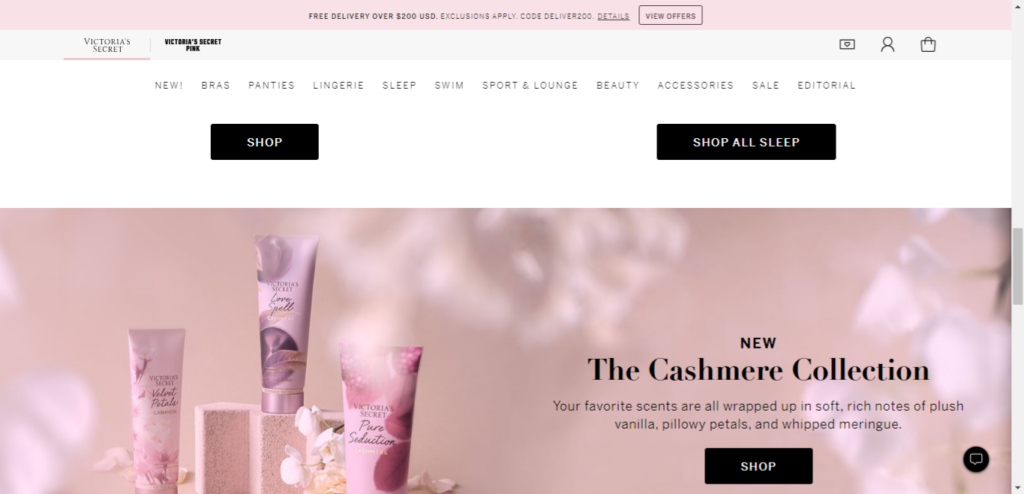
The product line is for women, so the visual design, categories, and homepage storytelling match that audience.
A brand that sells to both men and women would need a different default experience with clearer pathways for each.
Once your base experience is aligned to your most profitable audience, deeper personalization becomes far easier.
Quick actions: Define your primary audience, map their top tasks, and ensure homepage, nav, and category pages answer them in one click.
Encourage visitors to create a customer profile
Logged-in shopping lets you connect sessions, preferences, and purchases to a single customer—fuel for relevant recommendations.
Use accounts to learn what people love (and what they ignore) and tailor content accordingly.
Include a ZIP/postal code field to localize inventory, shipping ETAs, and seasonal merchandising.
This powers location- and time-aware offers—winter gear up north, sun protection for warmer regions, and accurate “arrives by” messaging.
Not every store has regional concentration, so global ecommerce sites should adapt by hemisphere and climate as well as holidays.
Speaking of holidays, align promos to the visitor’s calendar. A Fourth of July sale resonates in the U.S., but not in Spain or Germany.
People only create profiles when there’s obvious value. “Join now for a more personalized shopping experience” isn’t enough.
Take a look at what Champs Sports’ FLX Rewards offers members who create a profile:
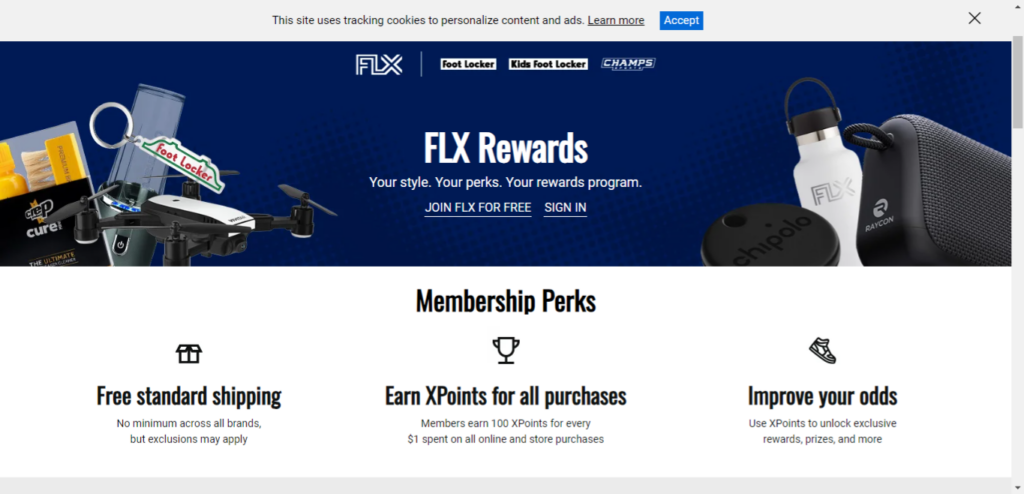
Exclusive perks, early access, and clear savings create a strong value exchange.
They stack benefit on benefit—and make sign-up obvious and low-friction.
For best results, offer fast account creation (Apple/Google sign-in or passkeys), progressive profiling (ask for more over time), and guest checkout that invites but doesn’t force account creation.
The personalization they’ll get is the bonus; the real hook is immediate, tangible value.
Get customers to add more items to their shopping carts
Cart-aware personalization uses the item(s) in the basket to recommend the next best product—complements, refills, or upgrades.
Maybe someone compared a few options and added just one item.
That’s your cue to surface relevant add-ons: matching accessories, extended warranties, or a bundle that saves 10–15%.
Here’s a perfect upsell opportunity that feels helpful—not pushy—because it’s tied to what they already chose.
Done right, this raises average order value without hurting conversion.
Let’s take a look at an example from SAXX Underwear:
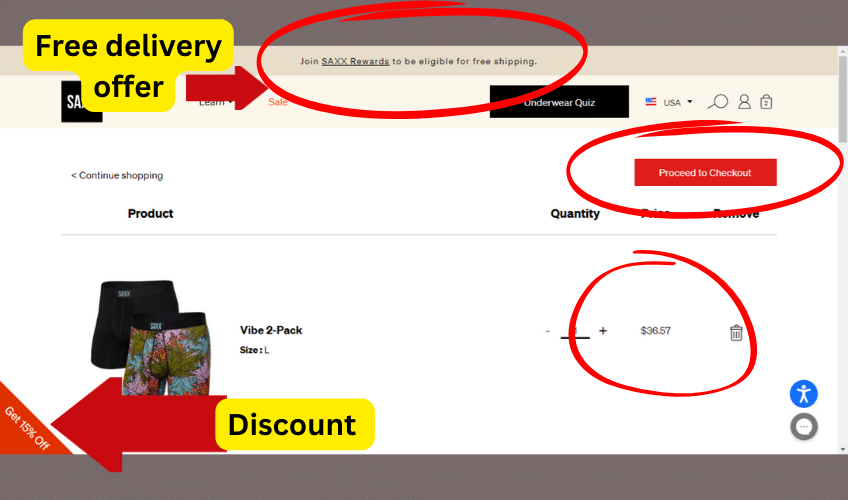
They prominently show a free-shipping threshold/progress in the cart. As of 2025, SAXX lists free standard shipping for U.S. orders over $100 for guests, with lower thresholds for loyalty tiers.
Since most people already have a second choice in mind, a contextual suggestion or a dynamic progress bar often seals the deal.
Small, timely prompts like these reliably increase order value with minimal friction.
Use popups sequences for new customers
If someone isn’t logged in, they may be new. Don’t assume they know your brand or navigation.
Use measured, well-timed popups and banners to orient and incentivize—especially on mobile where attention is scarce.
To improve learning curves and reduce hesitation, deploy popups that clarify benefits, answer common objections, or offer a welcome perk.
Here’s a great example from Julep. They use an intentional sequence for new customers—note the discount timing below:
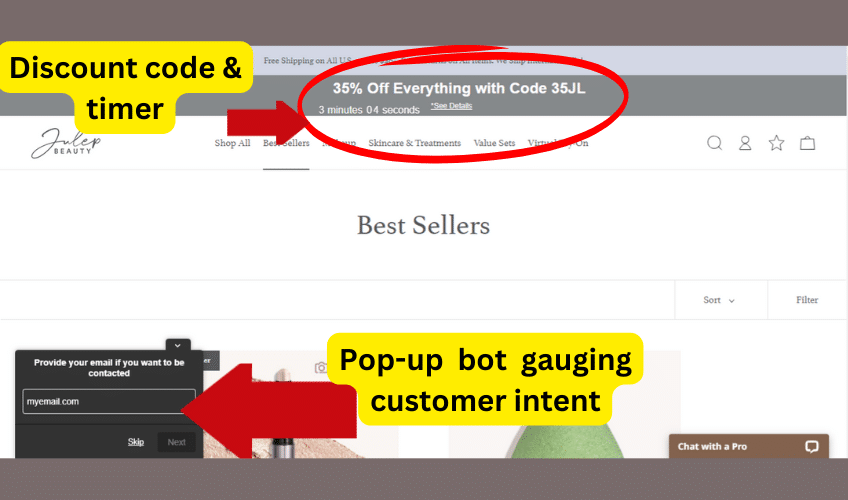
First, a non-intrusive popup asks what might be preventing a purchase—useful both for engagement and intent measurement.
This reduces guesswork and sets up a relevant next step.
Then they request an email:
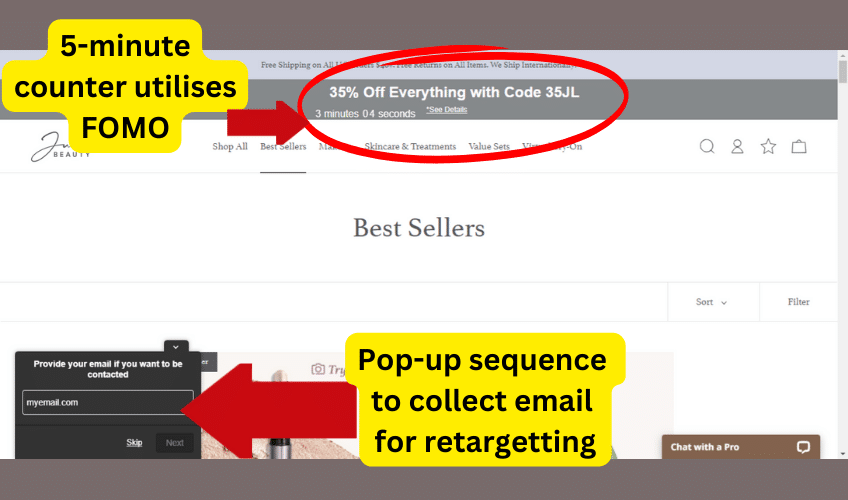
Notice the five-minute timer above the fold—hard to miss, but not overwhelming.
The light scarcity taps FOMO just enough to prompt action.
Even if a purchase doesn’t happen today, you’ve earned a contact you can nurture with useful content and personalized offers.
Popups have an average conversion rate ~4.65% (2025) based on billions of displays.
That may sound small, but at 10,000 monthly visitors, even average performance yields ~465 incremental actions—often email signups that compound over time.
Best practices: delay the first popup until scroll or intent signals, cap frequency, make closing easy, and avoid covering crucial content—especially important for overall page experience.
Used thoughtfully, popups are low-cost, high-leverage tools.
Reward customer loyalty
Your best customers deserve VIP treatment. Recognize and reward them to increase lifetime value and advocacy.
If they spend consistently, give them something meaningful in return—points, tiers, surprise-and-delight perks, or referral bonuses.
Loyalty reward initiation tends to work via three clear prompts:
- Reward new customers with a discount.
- Highlight the benefits of signing up for continued discounts.
- Remind returning customers to sign up for the rewards program.
Take a look at this rewards program offered by Foot Locker/Champs (FLX):
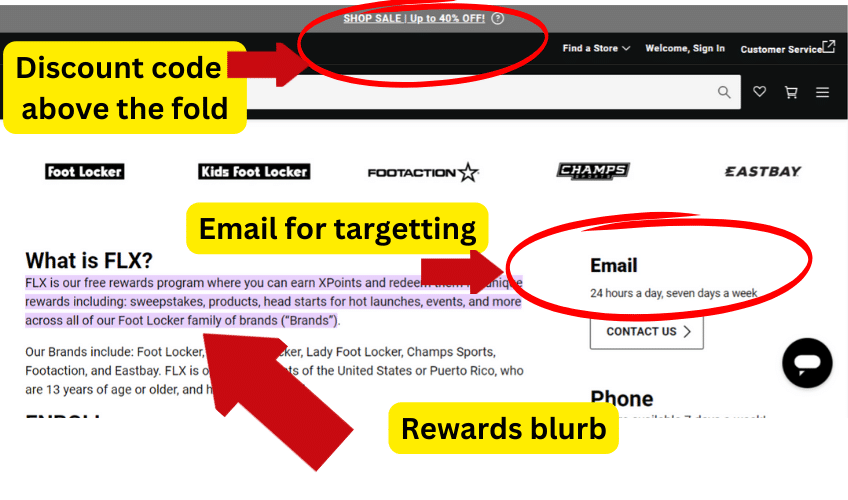
The page leads with clear benefits, partners, and how the program works—plus a simple email capture so interest turns into membership.
And yes, Champs Sports (a sister brand) runs similarly strong programs—the playbook is consistent because it works.
Rewarding people for spending more encourages them to keep going—especially when perks stack and progress is visible (think tier meters and milestone badges).
Recommend products to website visitors based on their browsing behavior
When someone browses, your job is to quickly infer intent and guide them to the right product.
This matters even more for stores with wide assortments or technical products.
Shoppers who engage with product recommendations tend to spend more—Salesforce reports a 26% higher AOV for those who interact with AI-powered recommendations.
We already know shoppers prefer retailers that tailor the experience. Recommendations operationalize that preference.
Start by segmenting products into intuitive categories.
We’ll use clothing as an example.
- Tops
- Bottoms
- Shoes
- Accessories
Those categories make navigation and recommendations clearer.
Amazon does this constantly and visibly:
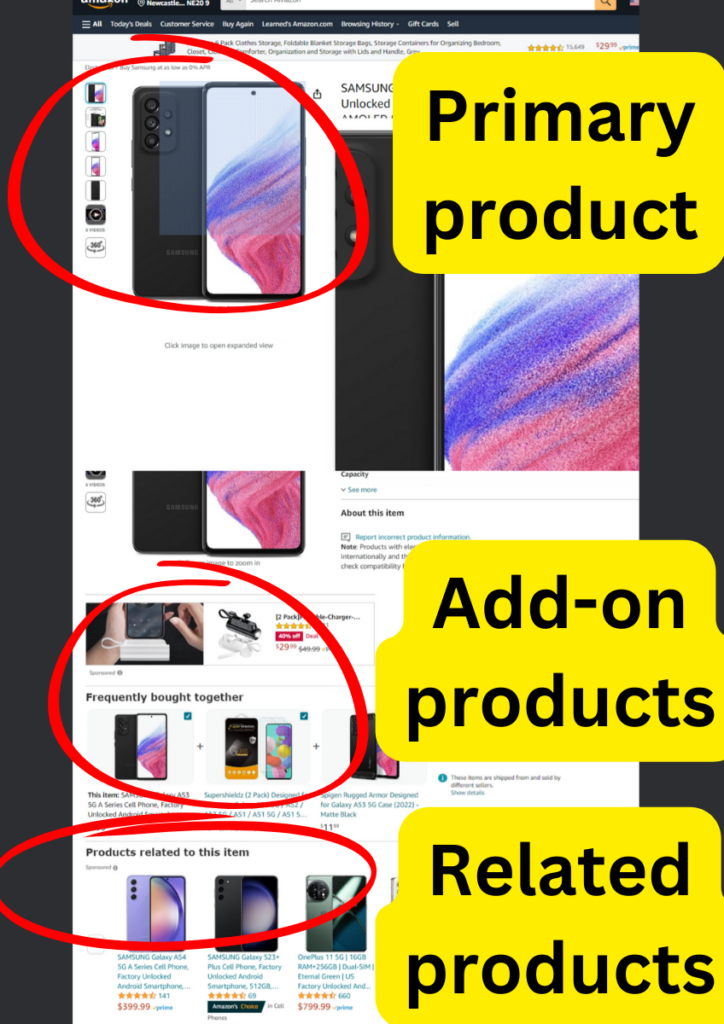
In the example, a user views a mobile phone. The page shows specs and reviews, then:
Two smart moves:
- Offer “frequently bought together” items to purchase simultaneously.
- Suggest related products in the same price and feature range.
The related items match model compatibility and price expectations, giving shoppers multiple, relevant ways to proceed.
Place recommendation modules on the homepage (“Continue shopping” and “Because you viewed…”), category pages (trending in this category), PDPs (complements and alternatives), the cart (don’t distract from checkout), and post-purchase (reorder schedules and refills).
Continue using personalization on other channels
On-site data powers off-site relevance. Use it to personalize email, SMS, and push—always with clear value and easy opt-outs.
Chances are you’ll collect emails via the tactics above.
Now extend personalization beyond your website with lifecycle messaging—welcome flows, browse and cart reminders, post-purchase care, and win-back sequences.
You can apply these same strategies to your email marketing campaigns.
Amanda Paterson notes that personalization improves their email marketing content.
Don’t limit personalization to your site alone.
Use first names in subject lines and messages when appropriate, but go beyond that—segment by category interest, price sensitivity, and location for weather-aware or store-availability messaging.
Pair behavior (what they did) with intent signals (what they seem to want next) for highly relevant yet respectful outreach.
Respect privacy, consent, and accessibility
Personalization only works long-term if customers trust you. Keep consent prompts clear, honor preferences, and explain how data improves their experience.
Offer easy controls to pause or change recommendations, and ensure popups and banners are accessible (keyboard navigable, labeled, and not obstructive).
Note: As of 2025, Chrome has not deprecated third-party cookies and has stepped back from a standalone deprecation plan. Regardless, build around first-party data, clear consent, and durable IDs.
When in doubt, favor transparency and utility over clever tricks.
Measure impact and keep iterating
Treat personalization like any CRO program—set a hypothesis, define success metrics, and run controlled tests.
Track: conversion rate, average order value, revenue per visitor, email signups, unsubscribe rate, and time to first purchase. Use holdout groups to verify lift.
Retire experiences that don’t move the needle; scale the ones that do.
Conclusion
If you want higher conversion rates, elevate the customer experience.
Personalization—done thoughtfully—helps visitors find the right thing faster and feel confident buying from you.
Start with your primary audience and build a great default journey.
Then encourage account creation with a strong value exchange and low-friction sign-up.
Use what you learn to tailor carts, recommendations, and promos—always in service of the shopper, never just the tactic.
Offer loyalty rewards that make spending more worthwhile and make progress visible.
Extend personalization into email and other channels with respectful, intent-driven messaging—then measure and iterate.
Finally, align with helpful content principles: answer intent clearly, avoid intrusive experiences, keep pages fast and accessible, and update content regularly.
Do all of this and you’ll see more conversions now—and stronger retention over time.
